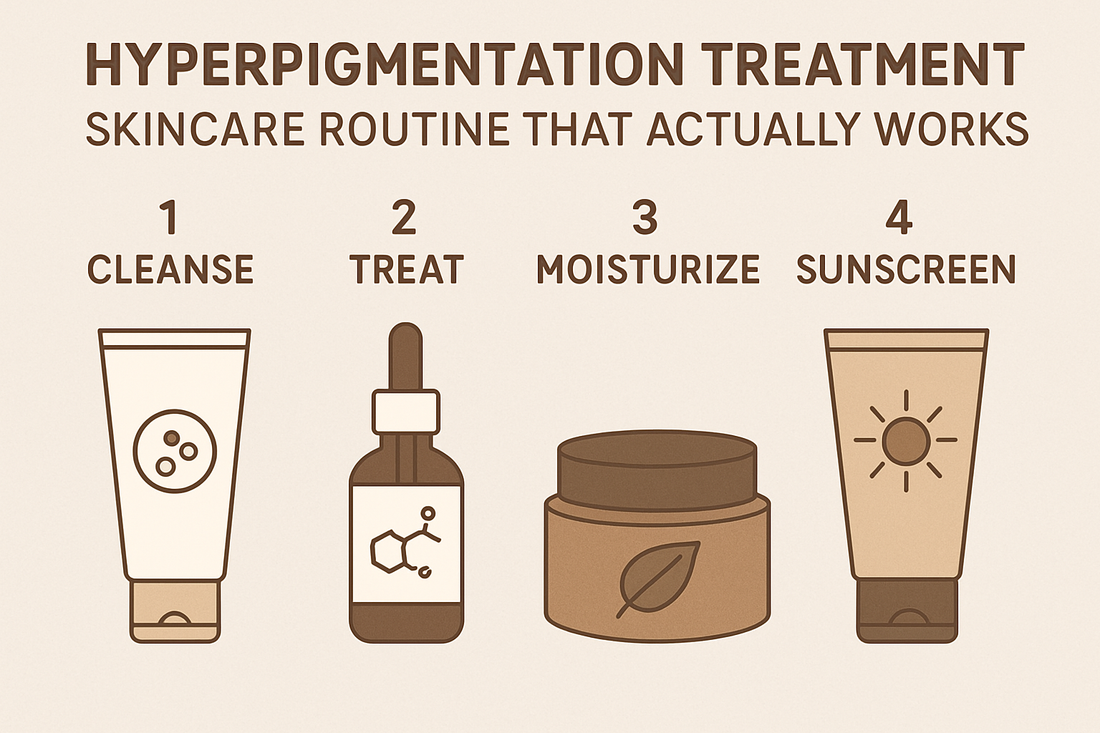
Hyperpigmentation Treatment Skincare Routine That Actually Works
Share
Understanding Hyperpigmentation: The Science Behind Uneven Skin Tone
Hyperpigmentation manifests when melanocytes—your skin's pigment-producing cells—go into overdrive, creating patches of darker skin that can persist for months or even years. This dermatological phenomenon affects millions worldwide, ranging from post-inflammatory hyperpigmentation (PIH) caused by acne scarring to melasma triggered by hormonal fluctuations.
The pathophysiology involves an overproduction of melanin, the natural pigment responsible for your skin's color. Various triggers activate this process: UV exposure, hormonal changes, inflammation, and even certain medications can stimulate tyrosinase, the enzyme responsible for melanin synthesis.
"Effective hyperpigmentation treatment requires understanding that different types respond to different approaches—what works for sun spots may not address melasma effectively."
Identifying your specific type is crucial for treatment success. Post-acne marks typically appear as flat, discolored spots where breakouts once existed. Solar lentigines (age spots) cluster in sun-exposed areas. Melasma presents as symmetrical patches, often across the cheeks and forehead.
Essential Ingredients That Target Melanin Production
A scientifically-backed hyperpigmentation treatment skincare routine relies on specific actives that interrupt melanogenesis at different stages. These powerhouse ingredients work through distinct mechanisms to fade existing discoloration and prevent future pigmentation.
Vitamin C: The Brightening Antioxidant
L-ascorbic acid remains the gold standard for addressing pigmentation concerns. This potent antioxidant inhibits tyrosinase activity while providing photoprotection against UV-induced damage. Concentrations between 10-20% deliver optimal results without excessive irritation.
Magnesium ascorbyl phosphate and sodium ascorbyl phosphate offer gentler alternatives for sensitive skin types. These stabilized forms convert to active vitamin C upon skin contact, providing similar benefits with reduced potential for irritation.
Retinoids: Cellular Turnover Accelerators
Tretinoin, adapalene, and over-the-counter retinol accelerate epidermal turnover, helping existing pigmented cells shed more rapidly. This process reveals fresh, evenly-toned skin underneath while preventing new pigmentation from settling into deeper dermal layers.
Begin with lower concentrations—0.25% tretinoin or 0.5-1% retinol—gradually increasing frequency to build tolerance. This measured approach minimizes retinization effects while maximizing therapeutic benefits.
Alpha Hydroxy Acids: Surface Exfoliation Champions
Glycolic and lactic acids dissolve the bonds between dead skin cells, facilitating the removal of pigmented surface layers. These chemical exfoliants also enhance the penetration of other active ingredients, amplifying overall treatment efficacy.
Building Your Morning Hyperpigmentation Treatment Routine
Morning routines focus on protection and prevention while incorporating gentle brightening agents. This strategic approach shields your skin from UV-induced pigmentation while addressing existing concerns.
| Step | Product Type | Key Function |
|---|---|---|
| 1 | Gentle Cleanser | Removes overnight buildup |
| 2 | Vitamin C Serum | Antioxidant protection + brightening |
| 3 | Moisturizer | Hydration and barrier support |
| 4 | Broad-spectrum SPF 30+ | UV protection (non-negotiable) |
Start with a pH-balanced cleanser that won't disrupt your skin barrier. Follow with vitamin C serum applied to clean, dry skin. Allow 10-15 minutes for absorption before layering moisturizer.
Sunscreen application requires special attention. Use at least one-quarter teaspoon for face and neck, reapplying every two hours during extended sun exposure. Physical sunscreens containing zinc oxide or titanium dioxide provide excellent broad-spectrum protection without potential sensitization.
Nighttime Treatment Protocol for Maximum Results
Evening routines accommodate stronger actives that might increase photosensitivity. This is when your skin enters its natural repair phase, making it the optimal time for intensive treatment protocols.
The Power of Alternating Actives
Rather than layering multiple strong ingredients simultaneously, alternate between different treatments throughout the week. This approach minimizes irritation while maintaining consistent progress.
- Monday, Wednesday, Friday: Retinoid application
- Tuesday, Thursday: Alpha hydroxy acid treatment
- Saturday: Gentle hydrating mask
- Sunday: Rest day with basic moisturization
Begin each evening routine with thorough cleansing, potentially incorporating a gentle exfoliating cleanser 2-3 times weekly. Apply treatments to completely dry skin, waiting 20-30 minutes between active applications and moisturizer.
Advanced Ingredient Combinations
Experienced skincare users can explore synergistic combinations like niacinamide with alpha arbutin, or kojic acid with licorice root extract. These partnerships often deliver enhanced results compared to single-ingredient approaches.
Tranexamic acid has emerged as a promising ingredient for stubborn melasma cases. This lysine derivative inhibits plasminogen activator, reducing inflammation-induced pigmentation. Studies show significant improvement when combined with traditional treatments.
Common Mistakes That Sabotage Treatment Progress
Many individuals inadvertently undermine their hyperpigmentation treatment efforts through well-intentioned but counterproductive practices. Understanding these pitfalls helps optimize your routine's effectiveness.
Over-exfoliation represents the most frequent mistake. Aggressive scrubbing or excessive acid use triggers inflammatory responses that can worsen pigmentation. Your skin requires time to adapt and regenerate between treatments.
Inconsistent sunscreen application negates months of diligent treatment. Even brief UV exposure can reactivate melanocytes, causing pigmentation to return with a vengeance. Indoor UV exposure from windows also contributes to pigmentation persistence.
Impatience leads to routine abandonment before results manifest. Hyperpigmentation treatment requires 6-12 weeks of consistent use before visible improvement occurs. Deeper pigmentation may require 3-6 months of dedicated treatment.
When to Expect Results and How to Track Progress
Realistic expectations form the foundation of successful hyperpigmentation treatment. Surface-level pigmentation typically responds within 4-8 weeks, while deeper melasma or post-inflammatory hyperpigmentation requires longer treatment periods.
Document your progress through consistent photography under identical lighting conditions. Weekly photos help identify subtle improvements that daily mirror checks might miss. This objective tracking method maintains motivation during the gradual improvement process.
Professional dermatological consultation becomes necessary when over-the-counter treatments fail to deliver results after three months of consistent use. Prescription-strength hydroquinone, chemical peels, or laser treatments may be required for stubborn pigmentation cases.
Remember that prevention remains easier than correction. A well-formulated hyperpigmentation treatment skincare routine not only addresses existing concerns but establishes protective protocols that prevent future pigmentation development. Consistency, patience, and sun protection form the trinity of successful treatment outcomes.
